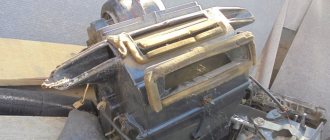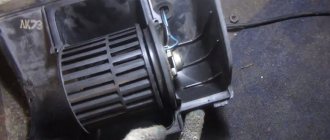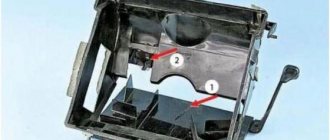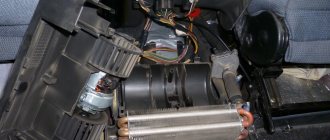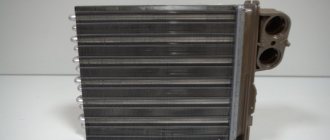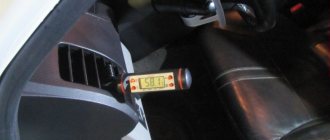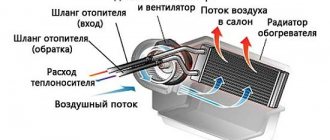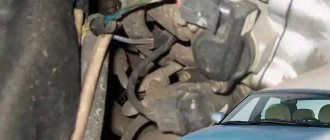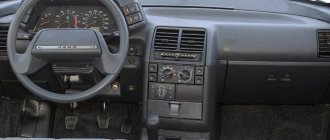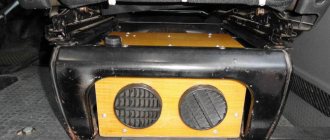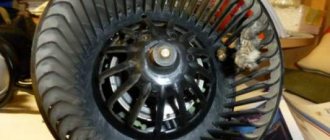Four problems with the stove: diagnosing it yourself
The source of heat in a car is the engine (electric cars do not count).
Its operating temperature is about 80–90 degrees. Excess heat is removed through the radiator, but with the arrival of cold weather, part of this heat is used to heat the interior. The process usually looks like this. The heater receives air - external air or, if the recirculation mode is turned on, internal air. It passes through the cabin filter, the air conditioner evaporator (if equipped), and then either through the heater radiator or past it, depending on the driver’s desire. Then, with the help of dampers, the air is directed to certain areas: on the glass, in the face or in the legs.
We figured out the design. Now let’s talk about the main reasons why a seemingly simple system can go on strike.
Useful tips
To avoid problems with the engine cooling system during operation, as well as to extend the life of the components (pump, thermostat), you cannot use ordinary water instead of antifreeze or antifreeze. It is also not recommended to use distilled water instead of antifreeze. This water should only be used to dilute antifreeze or antifreeze concentrate in the required proportion.
In this case, frequent addition of only distilled water to maintain the level leads to the fact that the density of the solution decreases. This can lead to freezing of coolant in the system in winter. To prevent this from happening, you need to check the density with a hydrometer. If necessary, the density is adjusted by pouring undiluted concentrate.
As a rule, the service life of antifreeze is 2-3 years (depending on the manufacturer, quality of the composition, engine condition, etc.). For example, the ingress of gases from the combustion chamber into the cooling system, severe overheating of the engine, general contamination of the cooling system, the use of special sealants for the “stop-leak” cooling system and other nuances can quickly render fresh coolant unusable.
The car radiator also needs to be periodically washed not only outside, but also inside. This will get rid of rust, scale, decay products of antifreeze or antifreeze, etc. The result is maximum performance of the cooling system, which eliminates engine overheating even in the most difficult conditions, as well as efficient operation of the stove in winter.
Checking the car cooling system pump. Main symptoms of malfunctions. Diagnostics of the water pump without removal, troubleshooting with removal from the engine.
How often does antifreeze need to be replaced? Self-cleaning of the cooling system from dirt, scale and rust. Products for flushing the internal combustion engine cooling system.
Reasons why coolant starts to leak. How to find the location of an antifreeze or antifreeze leak yourself. Useful tips and tricks.
The principle of operation of sealant for the engine cooling system. When to use sealant, what results to expect. Possible consequences, advice.
Do-it-yourself flushing of the engine cooling system radiator. How and what is the best way to flush the radiator from the inside without removing it from the car. Recommendations.
Rust in the engine cooling system and engine: what to do and how to remove contaminants. Affordable methods for cleaning the cooling system with your own hands.
Coolant does not heat up
It often happens that the engine has not yet warmed up, and the driver is already panicking. If you have a supercharged diesel engine or a gasoline turbo engine with direct injection under the hood, you will have to wait a long time! Their efficiency is higher than that of atmospheric engines, that is, more energy is converted into useful work rather than into heat, which is why such engines warm up more slowly. When moving, the heating speeds up significantly, which means the stove will blow out hot air earlier.
The engine may not warm up due to a malfunction - for example, if the thermostat is malfunctioning. When its valve loses its tightness, the liquid pump constantly drives the coolant in a large circle - through the radiator. There were also more comical situations: in the old days, many new Volgas did not want to warm up because they did not have thermostats - the distillers removed them on the way from the factory to the place of sale. The treatment method is simple: installing a new thermostat.
A more unpleasant and difficult to fix malfunction is poor circulation of coolant through the heater radiator. Causes? We bend our fingers: the radiator is clogged with deposits (or preparations to eliminate leaks), hoses are bent, heater taps do not work (this usually happens after the intervention of careless repairmen). More exotic reasons are also possible - from air locks in the heater radiator to corroded pump impellers. The repair methods are also clear: clean, straighten, replace.
Finally, if it’s really hot outside (minus thirty), then to speed up the warming up of the engine you shouldn’t neglect such an ancient technique as placing cardboard in front of the radiator slots. Unaesthetic, but effective. A special warm blanket under the hood will also help.
.
Air has entered the engine cooling system: the main signs of airing
For a better understanding, let's start with the general operating principles. While the engine is cold, the liquid circulates only through the cooling jacket (special channels in the cylinder block and cylinder head), without entering the radiator. Circulation is provided by a water pump.
After the coolant temperature reaches a certain value, the thermostat is activated, which opens a large circle (the liquid passes through the radiator). If cooling the coolant when driving in a large circle is not enough, then the engine cooling fan (air cooling) is automatically switched on.
Please note that these malfunctions can occur for various reasons, that is, the engine begins to overheat not only due to air locks, but this possibility should also not be excluded.
As with any closed fluid system, air pockets can cause the system to stop operating normally. In this case, the risk of engine overheating also increases significantly, and the stove stops working normally.
- The main sign of air lock formation is engine overheating. In other words, the temperature rises above normal, the temperature gauge may rise to the red zone. In this case, when checking the coolant level in the expansion tank, no deviations may be detected.
- Also, during the cold season, the driver may notice that practically no warm air enters the cabin, although the engine is normally warmed up. This also indicates that there may be air in the cooling system.
One way or another, the air lock does not allow coolant to circulate normally through the channels of the cooling system. As a result of impaired circulation, certain problems arise. As part of diagnosing the engine cooling system, you should check the coolant level in the expansion tank, and also carefully inspect individual areas of the system.
We also note that air can enter through subtle cracks in the rubber pipes, but there may not be intense leaks through these cracks. Usually such cracks are not immediately visible, but a detailed inspection or injection of air into the system under pressure for testing can reveal problem areas. Also, during the check, you should pay attention to the pump, check the operation of the thermostat and cooling fan.
If everything is normal, then there is a high probability that the stove is not working and the motor is overheating precisely because of air locks. In this case, it is necessary to take measures and “drive” such a plug from the cooling system.
The air does not heat up
Antifreeze is hot, but there is no heat? Most likely, the air got stuck somewhere along the way, such as a clogged air filter. Another suspect is the air conditioner evaporator, which is where air must always flow through. Perhaps it is also clogged. This often happens when driving for a long time without a cabin filter. The repair method is obvious: buy a new filter, try to clean the evaporator, and if that doesn’t work, replace it.
On older cars, the heater radiator is often overgrown with a layer of dust, which, under the influence of temperature, becomes tightly welded to its surfaces over time. In this case, the efficiency of the stove inevitably decreases, since dirt transfers heat much worse than clean metal plates.
Preventing the operation of the stove in the cabin
To prevent the stove from failing at the most inopportune time, you must follow simple rules:
- High quality antifreeze.
The operation of not only the stove, but also the engine depends on its properties. It is necessary to use only good antifreeze and replace it regularly according to the requirements of the car manufacturer.
Clean radiator.
External dirt and insects on the radiator can be removed using a vacuum cleaner. The internal cavities can be cleaned using special means for flushing the engine cooling system.
- Cabin filter.
A dirty cabin filter worsens not only the heating intensity of the cabin, but also the ventilation and air conditioning system as a whole. And since a clogged filter often contains pollen from various plants, driving in such a car for allergy sufferers can result in an exacerbation of the disease.
When to consider stove operation abnormal
It is believed that if it is -25 degrees outside, then a properly functioning heating system should provide a temperature of at least +16 degrees from below the cabin and +10 at its ceiling. If these values are lower, then the stove is faulty.
It should be remembered that the older the car is, the more attention should be paid to maintaining the heating system. Compliance with all the above rules and recommendations will help keep it in good condition, regardless of the year of manufacture and make of the car.
Video about why the heater in the car doesn’t heat up:
The flap does not obscure
If the damper, which directs air either through the heater radiator or bypass, begins to act up over time, then some of the cold air (or even all!) will go past the heater radiator without any heating. How much time and money will you have to spend on repairs? If the damper actuator is stuck, cleaning and lubricating it usually helps. And if the damper itself has fallen into pieces, you will have to look for the same one at a disassembly site - do not buy an assembled heater unit. The cost of replacement work depends on the vehicle and the complexity of the heating system.
How to use the heater correctly
After starting the engine, set the electric fan to low speed. Immediately direct the air flow to the windshield: let it warm up slowly and not abruptly, otherwise it may burst from a sharp temperature change. Do not switch the fan speed to a higher speed ahead of time - you will only get a cold draft, because an unheated radiator gives off too little heat. Use the recirculation system at first, since it is easier to heat warmer cabin air than outside air. As it warms up, turn off recirculation to prevent the windows from fogging up.
Source
The stove got airy (((Help
Start the engine without closing the radiator cap, raise the speed to 1200-1400, gradually add antifreeze until the bubbles stop. In general, when driving, a working pump should push through on its own.
As an option: drive the front up a steep hill and hold the speed at 2-3 thousand until the heater return hose warms up. The fact is that in many cars the stove is located above the level of the radiator and air accumulates in it. I myself had such a trick. Good luck!
Is it like under vacuum, in airless space or something? The service station won't tell you that yet. Another option: park the car with its face up, remove the heater return hose, start adding antifreeze until it comes out of the return line. Then the hose is put in place, and start. RPM 1500 minutes 2-3, turn off, check the level, top up, start again, etc. until warm air comes out of the stove. Good luck. By the way, is the air coming out of the stove completely cold or not warm enough?
Mayevsky crane and automatic air vent
A simple device designed to eliminate air pockets will help eliminate airiness in the heating system and avoid problems with the law. The tap opens until air begins to escape.
Only a small amount of water will flow through the Mayevsky tap
At this time, water may ooze out, so you need to prepare the container in advance . The Mayevsky faucet is good because it has a very small hole through which a lot of water will not leak. As soon as the air is completely released, the device is closed. The installation of this element is permitted by regulations. The disadvantage of the faucet is that it has to be unscrewed and screwed in manually.
When air accumulates in the pipes too often, unscrewing the faucet can become a problem: not everyone wants to perform this tedious task several times a week. Therefore, it makes sense to consider another device - an automatic air vent (air vent). This is an auxiliary element, which is a body made of bronze or stainless steel.
Often the air vent is installed with a shut-off valve. Installation is carried out in this order: first screw in the valve, then screw the air vent into it. Principle of operation :
- air enters the housing and is released;
- when water begins to flow, it raises the float;
- the float presses the valve.
Thus, the device allows air to pass through, but does not allow coolant to leak out. However, the homeowner should be careful in any case, especially when it comes to a centralized heating system.
The pressure in the pipes is very high, and if you often bleed the air by unscrewing the structure or opening the tap, a breakdown may one day occur. For frequent problems, it is better to invite specialists . Often, only they can determine the true cause of air in the heating system of an apartment building and take the necessary measures.
Communities › VAZ: Repair and Modification › Forum › air the stove in the morning
The essence of the problem is already partially clear in the title. Every time I start the car in the morning to warm it up, I turn the heater on to 1 and go have breakfast. then I get into the car, and a barely warm blow comes out of the nozzles; when I accelerate a little, I hear gurgling in the radiator of the stove, and immediately hot air comes out even at idle (provided that the engine is warmed up). It bothers me to expel the air every time, I want to get into the warm interior of the car.
The system may not be sealed, check the lid first
expansion tank cap? I changed it, but there are small smudges on the tank, and strangely the antifreeze does not leave
I checked the cover like this, on the right there is a small outlet for the radiator, I took it off, put on the hose from the pump, pumped it a couple of times and looked at whether the cover was holding or not, changed 3 caps like that, and eventually changed the tank, crooked casting, the cover did not fit tightly, I sharpened edge didn't help
were there any leaks on the tank too?
The pressure didn't hold
The lid must also work in the opposite direction, that is, not only keep the pressure within 0.8-1.1 kg/cm, but also must let air into the system when it cools. If the lid is vacuumized, “waterfalls” are guaranteed. You can simply check with your mouth, you need try to suck in air through the lid; it should be sucked in with little resistance. It is advisable to tighten all the clamps and check the system for leaks, for this you need to do everything according to the advice of Slavik792, but with a pressure gauge, pump up the pressure to about 1 kg/cm. The pressure should not drop within 10 seconds. Good luck!
It seems to release pressure, the expansion valve doesn’t inflate, but it can’t suck in air
I have had 5 caps and it always bubbles. install an electric pump
there can be no air there, the stove is the lowest point. your radiator is clogged, change it and it will blow. Today I dealt with only 15 with the same diagnosis. You can check this: don’t turn on the fan, let it warm up, then turn it on, warm air will come out and slowly cool down. due to the fact that the stove below all the garbage settles in it
I have a new heater radiator that is clean and will also sit for a while and cool down, then you start it up and it starts bubbling! I’m amazed where the air comes from. One guy explained to me that antifreeze cools and shrinks
the fact that it is compressed can be seen from the expander, the level changes. cold less. do you have an injector? When you fill in antifreeze, remove the tube on the throttle and the air comes out of it, since it is the highest point. If it's carb, then it's from the suction manifold, and the fuel flows out of the hose until it flows. and there is never air in the system.
injector, but there is nothing on the throttle... since the plugs come out fine through the steam hose from the radiator, if of course the pump is working and there is good circulation. I've had my car for 5 years and the stove has been bubbling when it heats up for the same number of years. so many things have been redone, changed... in winter I install a pump, it expels the air perfectly
will air the stove
Good day. I've read everything I can but haven't found the answer yet. The problem is this: at idle the heater blows slightly warm air, but when the engine speed increases, the heat cannot be tolerated by the hand. I checked the antifreeze level - it’s normal, the radiator cap also seems to be normal, the temperature does not drop normally, it heats up normally. I began to delve into the essence, assembled the device and this is what it turned out - you increase the speed to 4-5 thousand and bubbles begin to come from the neck of the radiator, but just a little bit for a while, 1-2 seconds, literally a couple of bubbles then stops, reset to idle - a couple more bubbles, I'm jamming a couple more. I start the stove again, it heats up weakly, I pump all the pipes (all I can), some more air comes out, it heats a little better, I add speed and heat, I lower it to idle for a minute and again it’s a little warm, again I manipulate the pipes - better but not much. and so on for 3 hours! I'm sinning with the cylinder head gasket, but there are a number of issues, namely the oil is clean, the level is normal, anti-freeze is the same, nothing drips from the pipe, I noticed this problem yesterday (the first frost was 32 degrees) I drove 1300 km and nothing changed. I think that if the gasket I would have gotten up a long time ago. please help with advice.
Well, I advise you to do the simplest thing first. Replace the plug after all. It may look good, but it could be the cause. People have already had this happen. I had a gurgling gurgle because of a plug (only a different car), but what difference does it make? brand. It’s easier to do an experiment with a plug than with a gasket. Change it, and then it will show. The second step, if the plug doesn’t help, I personally would flush the heater radiator, maybe it doesn’t warm up well at low speeds due to dirt. This is taking into account that, as you say, the antifreeze doesn’t go away. The stove can be effectively washed in one hour without removing it. On TOYOTE it was the same with the stove at idle. I washed it, it became gutt, you couldn’t hold your hand.
Oh, I literally recently resolved this issue, everything turned out to be simple for me, I looked at the antifreeze was normal, and the stove behaved as you described, I decided to extend it as long as it would fit, and a liter fit, and by the looks of it the radiator was full and had an expansion level. And the gasket can be easily checked without replacement and is 99% accurate. You take the hose that goes into the expander, pull it out and put it in a glass of water, remove the radiator cap and plug it with a rag, then start it and rev it up slightly to 2000, and if bubbles appear, then the gasket, no, then the gasket was excluded. Then there remains a plug, and dirt in the stove radiator, I think it’s unlikely in your case, the stove wouldn’t heat up.
I’ll try to buy a cork tomorrow, I’m also thinking about it, then we’ll see, I’ll draw conclusions, and I’ll write about the results.
Causes of poor-quality stove operation
There may be several reasons why the stove is not working satisfactorily; let’s look at the main ones.
Before you start troubleshooting, you must carefully familiarize yourself with the structure and operating principle of the vehicle heating system. The design of the interior heater on all cars is almost the same; it consists of the main elements:
- fan motor;
- air duct system;
- inlet and outlet pipes;
- stove heat exchanger;
- valve for adjusting the coolant supply;
- heater operation control unit;
- dampers with mechanical or electrical drive.
Typically, the reason lies in one of these elements:
Malfunction of the heater control unit
A faulty control unit (controller) is detected by unstable fan operation in certain modes. An incorrectly functioning air temperature sensor in the car interior can also affect the operation of the unit - it will give incorrect commands, and it will be impossible to ensure a comfortable temperature in the car.
Failure of the antifreeze supply valve
This malfunction is very common in Russian-made cars. Mechanical deterioration or souring of the faucet occurs, the rubber sealing elements are squeezed or dry out.
In this case, the faucet must be replaced, and it is advisable to replace it together with the radiator.
Cabin filter
Many car enthusiasts neglect the cabin filter - they either never change it or simply throw it away. But do not forget that a clogged cabin filter can become an obstacle to the flow of warm air into the car interior.
Fan fault
It happens that the fan motor fails. This can be expressed in a whistle during its operation, a constant change in rotation speed from minimum to maximum and vice versa. With such a breakdown, the heater radiator may be hot, but this will not be enough to heat the interior.
The main reasons for this type of motor operation are wear of the graphite brushes of the commutator and failure of the shaft bearing. If the motor does not work at all, you need to check the fuse or relay in the electrical power circuit.
Thermostat
This device is directly involved in regulating the coolant circulation circles. When the engine warms up immediately after starting, antifreeze circulates in a small circle, which involves the engine cooling jacket and the stove radiator.
When the engine reaches operating temperature, a large circulation circle opens, into which the main radiator of the cooling system is added.
A faulty thermostat will directly affect the temperature inside the car. It has two working positions: open and closed. Its failure is characterized by jamming in one of these positions.
- If the thermostat is stuck in the open position, this becomes clear from the coolant temperature. When driving in high gears, it will be below normal, and accordingly, the air temperature in the car will be low. When driving in low gears with frequent stops and accelerations, the fluid temperature will be normal.
- If the thermostat is stuck closed, the coolant temperature will be normal if you drive in 4th and 5th gears. But driving in city mode will cause the antifreeze temperature to rise, and the air temperature inside the car will also rise. But due to the high temperature of the coolant, the engine may overheat, which can lead to engine failure.
Heater heat exchanger clogged
Over time, deposits form inside the radiator, consisting of dirt and foreign impurities that are somehow present in the cooling system. Also, the cause of such growths in the pipes may be the antifreeze itself, if it is of poor quality.
Also, the internal cavities of the heat exchanger can become clogged due to improper mixing of antifreeze. For example, it is strictly forbidden to add G11 to G13 antifreeze. The resulting sediment will soon damage the radiator.
In addition, the outside of the heat exchanger can become clogged with dust, dirt, insects, and fallen leaves.
Air cooling system
If air gets into the cooling system of the car's engine, the heater will not be able to fully perform its function.
Air may be getting in due to a leak in the cylinder head, which can be fixed by installing a new gasket.
You should also check the antifreeze level. If there is not enough of it in the system, the stove radiator will not be able to warm up to the required temperature. Air will flow into the cabin, but it will be either slightly warm or cold.
In this case, it is necessary to bring the antifreeze to normal by pouring it into the expansion tank. If the level drops again, check all hoses and pipes for leaks.
You should also inspect the main radiator and stove. If there is a leak, the radiator is replaced. Although there is a wide range of special sealants for radiators on the market, it is not recommended to use them, since the reliability of such products is usually low.
Why does the cooling system “air” occur?
There is a tendency to voice a number of reasons why the fact of a given malfunction stands out. Often this is a mistaken replacement of the coolant, in particular when fresh antifreeze enters the desired container through a small neck in a wide stream.
As a result, many small bubbles form in the coolant, which later accumulate in bottlenecks in the system, creating impressive air pockets. You can drive them out, but this is unattainable using pressure from the pump alone.
In addition, this phenomenon occurs in cases where there is damage to the hoses and pipes through which air enters the joints. The challenge is to locate these leaks, which is not easy. It is necessary to diagnose the vehicle, identifying smudges, and in this it is necessary to use special antifreezes of bright red or acid green color. This will simplify the described procedure.
What will tell you about the current problem? In such cases, you will notice several typical symptoms.
Their characteristics are as follows:
How can you remove an air lock from the cooling system?
- 131 6 107k
- 205 2 202k
The presence of air in the cooling system is fraught with problems for both the engine and other components of the car. In particular, overheating may occur or the stove will heat poorly. Therefore, it is useful for any motorist to know how to remove an air lock from the cooling system. This procedure is quite trivial, so even a beginner and inexperienced car enthusiast can do it. Due to its importance, we will talk about three methods of removing air. But first, let's talk about how to understand that air jams are occurring and the reasons for their occurrence.
